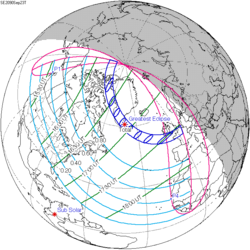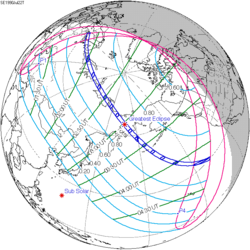| Annular eclipse | |
| Gamma | −0.3125 |
|---|---|
| Magnitude | 0.9285 |
| Maximum eclipse | |
| Duration | 467 s (7 min 47 s) |
| Coordinates | 28°18′S166°12′W / 28.3°S 166.2°W |
| Max. width of band | 281 km (175 mi) |
| Times (UTC) | |
| Greatest eclipse | 23:56:07 |
| References | |
| Saros | 131 (52 of 70) |
| Catalog # (SE5000) | 9607 |
An annular solar eclipse will occur at the Moon's ascending node of orbit on Thursday, February 16, 2045, [1] with a magnitude of 0.9285. A solar eclipse occurs when the Moon passes between Earth and the Sun, thereby totally or partly obscuring the image of the Sun for a viewer on Earth. An annular solar eclipse occurs when the Moon's apparent diameter is smaller than the Sun's, blocking most of the Sun's light and causing the Sun to look like an annulus (ring). An annular eclipse appears as a partial eclipse over a region of the Earth thousands of kilometres wide. Occurring about 2.8 days after apogee (on February 14, 2045, at 3:00 UTC), the Moon's apparent diameter will be smaller. [2]
Contents
- Images
- Eclipse timing
- Places experiencing annular eclipse
- Places experiencing partial eclipse
- Eclipse details
- Eclipse season
- Related eclipses
- Eclipses in 2045
- Metonic
- Tzolkinex
- Half-Saros
- Tritos
- Solar Saros 131
- Inex
- Triad
- Solar eclipses of 2044–2047
- Saros 131
- Metonic series
- Tritos series
- Inex series
- Notes
- References
- External links
The path of annularity will be visible from parts of New Zealand, the Cook Islands, French Polynesia, and Kiribati. A partial solar eclipse will be visible for parts of Australia, Antarctica, Oceania, Hawaii, and southwestern North America.





































































































